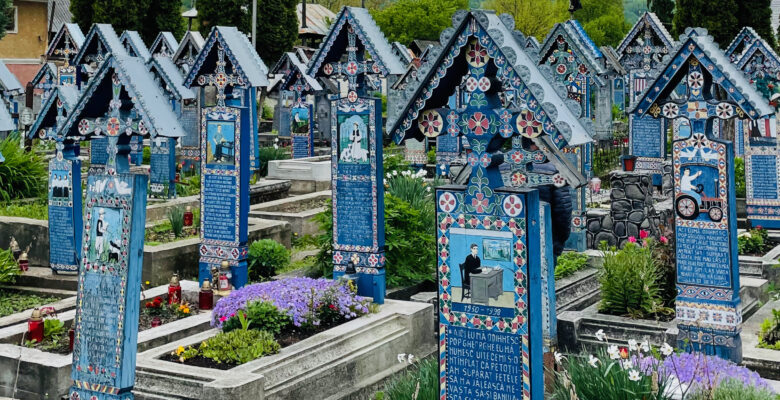Epigram(s) of the month: The poetics of the Merry Cemetery
There are many incredible, beautiful, and curious places in the world to explore for anyone who, like us at the MAPPOLA project, wish to study the poetics of death and commemoration in their concrete, spatial manifestations. Perhaps you remember our post regarding Vienna’s Cemetery for the Nameless, a few months back?
Well, this month’s post will take you to a truly extraordinary place: the Merry Cemetery!
The Merry Cemetery is a cemetery situated in Săpânța, a small village in the northern part of Romania’s Maramureș region, closer to Romania’s border with Ukraine. The cemetery, “Cimitirul Vesel” in Romanian, represents the lifetime work of folk sculpture, painter, and poet Stan Ioan Pătraș (1908-1977), and his work is continued to the present day by one of his apprentices, Dumitru Pop (also known as Tincu).
In 1935, Stan Ioan Pătraș starts carving the first poems on the crosses and gradually, he improved his technique by making the crosses narrower, adding, in addition to carved scenes from the deceased’s life, colorful geometric and floral motifs which resemble those on traditional costumes and woven rugs.
Blue was the main color, and which represents the sky, freedom and hope.
Green represents life, yellow – fecundity and fertility, red – passion, and black – death.
Other symbols that appear on the crosses include doves, representing the soul, and a black bird, symbol of suspicious or tragic death.
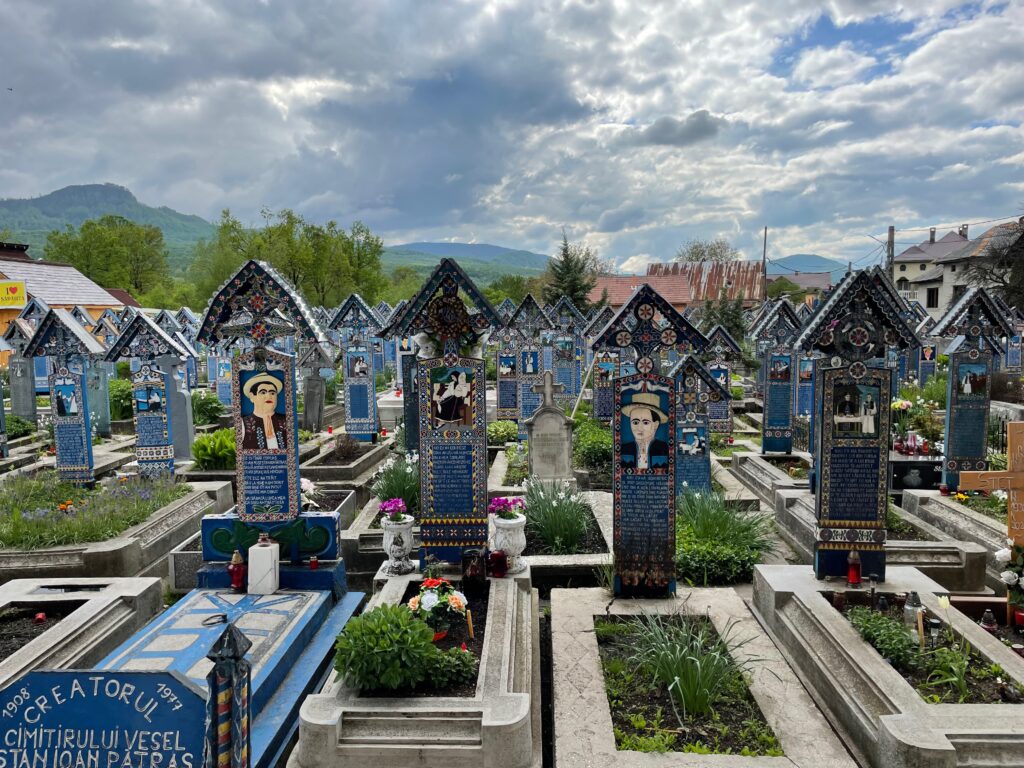
A Merry Cemetery? What is a Merry Cemetery?
Death is a serious matter, and by no means do we wish to suggest that death does not cause great pain and suffering. On the contrary. Death causes immense grief and sadness.
However, there can also be beauty in it: a truly poetic beauty.
Funerary monuments could – and arguably should – provide some form of comfort for those left behind. And Săpânța’s Merry Cemetery is by no means a merry cemetery in the sense that has an especially cheerful characteristic feature, making light of death, loss, and mourning – quite the opposite, in fact: the epitaphs from Săpânța express deep and painful, sober and sad, tormenting or consoling feelings and thoughts, and they are a true testimony to the hardships of life and the horrible ways in which it might end.
It is a merry cemetery mostly because even in this hardship and grief life prevails over death.
We get to remember things a person did or experienced in their life (or at the end of it), vivid and with great, undiluted immediacy. We are confronted, unmitigated, with the reality of human lives.
Honest, outrageous, liberating, wholesome, without filters.
And yet it all rhymes somehow.
How, when, where did the artist get his inspiration from?
According to Romanian tradition, in the three days from death to burial, but especially during the night (in the wake), the family, together with close friends of the deceased, gathered to commemorate their life, rather than mourning them.
It is also common, especially in the Maramureș region, to have wailers at the wake. They may be professionals or members of the family. And when they start to tell the life of the deceased, the atmosphere is not so overwhelming(ly dark) anymore. And this is precively from where Stan Ioan Pătraș drew his inspiration. He wanted to create a place in which the death, even though painful and sad, is not a tragedy.
At Săpânța, the oak wood crosses, painted in a specific blue colour (Săpânța blue), feature a carved scene and verses, trying to capture the most important aspects of life of the deceased. The sculptures are often naive, childlike from a technical point of view perhaps, but together with the epigrams, written in the Maramureș dialect, they create truly unique monuments. Moreover, through the use of the first person singular in these texts, the dead still has a voice, is not silenced.
The Merry Cemetery from Săpânța is the place where „the crosses do not only guard graves, but speak explicitly in words.”
Thus, I propose to let some of them speak…
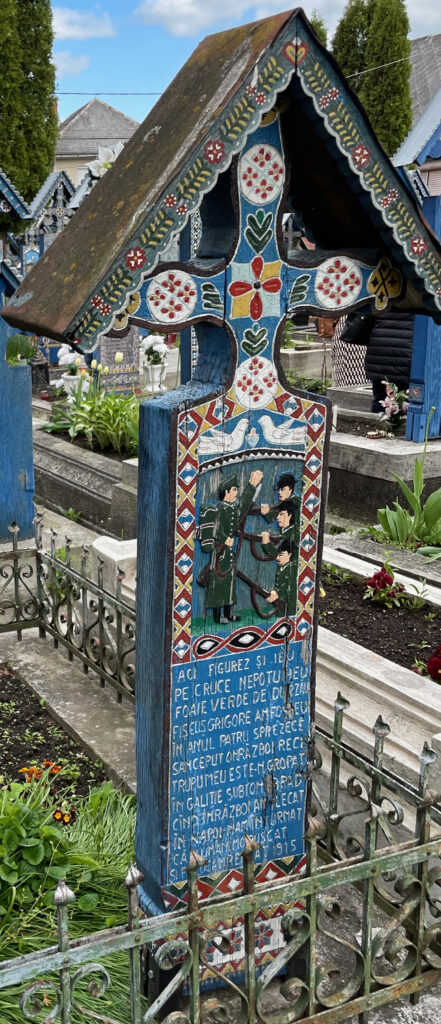
ACI FIGUREZ ȘI IEU
PE CRUCE NEPOTU MEU
FOAIE VERDE DE DURZĂU
FIȘCUȘ GRIGORE AMFOSTEU
ÎN’ANUL PATRU SPREZECE
SANCEPUT ONRĂZBOI RECE
TRUPU MEU ESTE-N GROPAT
ÎN GALIȚIE SUBTON BRAD
CÎND ÎNRĂZBOI AM PLECAT
ÎN NAPOI NAM ÎNTURNAT
CĂ DUȘMANI MO ÎMPUȘCAT
ȘI PE LOCAMREPSAT AT 1915
Here my name is inscribed
On this cross (made by) my grandson.
A green dwarf-fir leaf,
Fișcuș Grigore I was.
In the year 1914
A cold war began.
My body is buried
Under a fir-tree in Galicia.
When I left for war,
I did not return home
because the enemies shot me
and I died right on the spot. Died in 1915.
Epitaph of Grigore Fișcuș. Photo: D.M. (May 2021)
One particular aspect that caught my attention is the association between the soldier and and the fir-tree leaf. This image was not chosen just randomly, solely to create a rhyme. Each plant carries meaning. In Romanian folklore, the fir-tree is a symbol of male youth. A fir-tree is a giant tree, always green, young, and immortal. It represents strength, vitality, vigour, and thus it is associated with the prime age of a young male. In this case, however, the soldier is associated specifically with a dwarf-fir which emphasises even more the prime of his life.
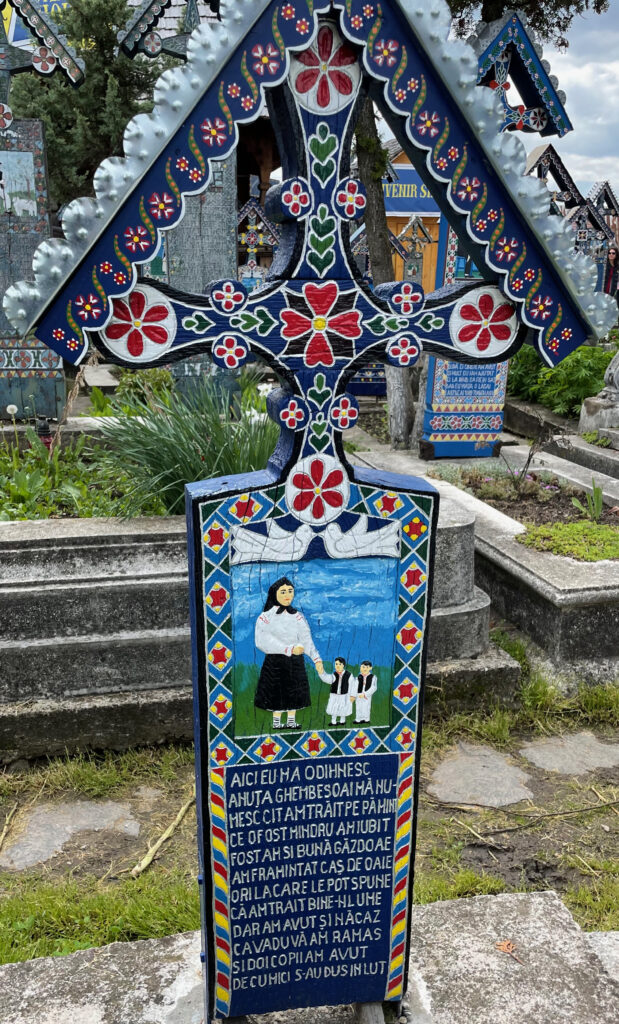
AICI EU MĂ ODIHNESC
ANUȚA GHEMBESOAI MĂ NU-
MESC CÎT AM TRĂIT PE PĂMÎNT
CE O FOST MÎNDRU AM IUBIT
FOST-AM ȘI BUNĂ GĂZDOAE
AM FRĂMÎNTAT CAȘ DE OAIE
ORI LA CARE LE POT SPUNE
CĂ AM TRĂIT BINE-N LUME
DAR AM AVUT ȘI NĂCAZ
CĂ VĂDUVĂ AM RĂMAS
ȘI DOI COPII AM AVUT
DE CU MIC S-AU DUS ÎN LUT.
Here I rest, quite cold,
Anuța Ghembesoai I was called.
As long as I lived on earth
Everything of beauty I loved.
I was a good hostess,
I kneaded sheep cheese.
To anyone I can tell that I lived in harmony,
But I had downs too,
For my husband passed away,
And the two children
Lie since childhood under the ground.
Epitaph of Anuța Ghemeșoai. Photo: D.M. (May 2021)
NE ODIHNIM PE VECIE
NOI TREI FRAȚI DIN CUCONIE
CĂ O GREA BOALĂ NE-A LOVIT
ȘI LUMEA O AM PĂRĂSIT
VOI DRAGII NOȘTRI PĂRINȚI
DE NOI NU VĂ BĂNUIȚI
CĂ AȘA NE-A FOST SĂ FIE
SĂ MURIM DIN CUCONIE
POP GHEORGHE Tr. 7 ANI
Mr. 1974 ION Tr. 4 ANI Mr. 1965
DUMITRU Tr. 4 ANI Mr. 1968
Here we forever rest
We, three brothers, since childhood
For a tough disease pounced on us,
And the world we left.
You, our beloved parents,
Do not worry about us,
For that’s how our destiny was:
To die in childhood.
Pop Gheorghe lived 7 years,
Died in 1974, Ion lived 4 years, died in 1965,
Dumitru lived 4 years, died in 1968.
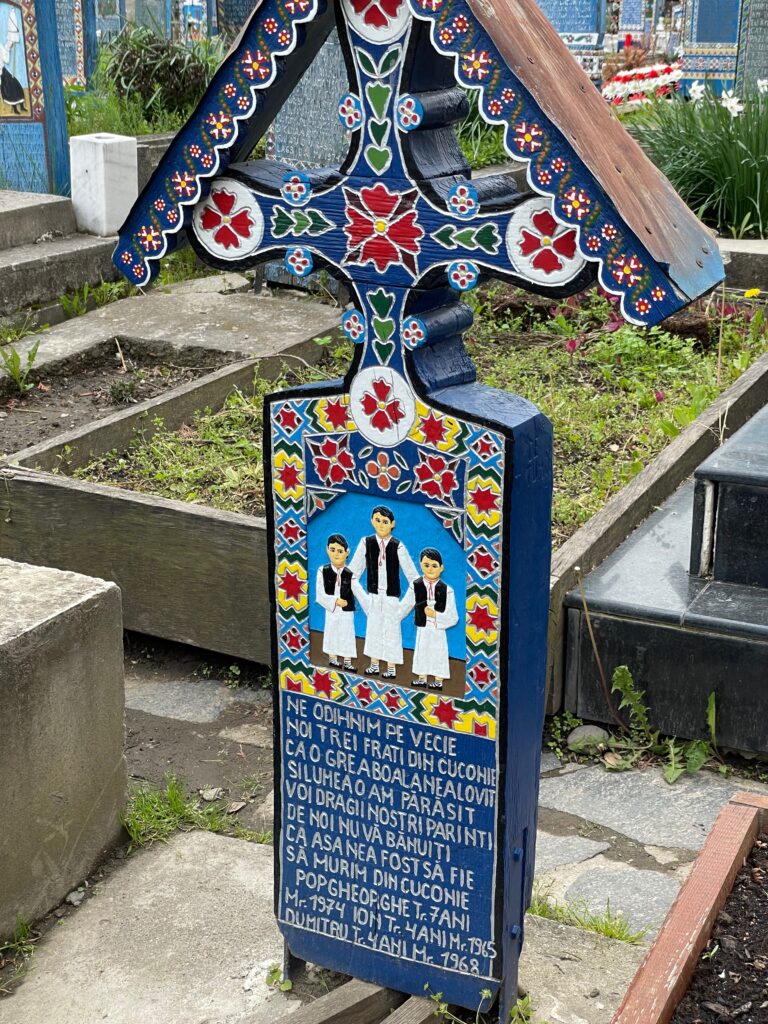
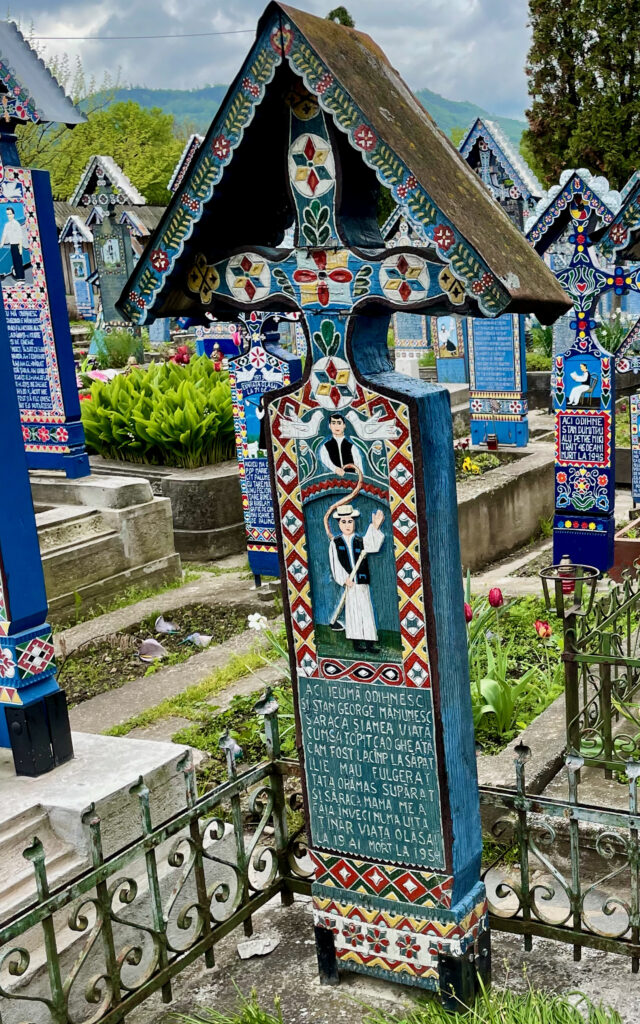
ACI IEUMĂ ODIHNESC
ȘI STAN GHEORGHE MĂNUMESC
SĂRACA ȘIAMEA VIAȚĂ
CUM SA TOPIT CA O GHEAȚĂ
CAM FOST LACÎMP LA SĂPAT
ILIE MAU FULGERAT
TATA ORĂMAS SUPĂRAT
ȘI SĂRACA MAMA ME A
CĂIA ÎNVECI NUMA UITA
TÎNĂR VIAȚA OLĂSAI
LA 19 AI MORT LA 1954
I rest here quite cold,
And Stan Gheorghe I was called.
And my poor life
Melted like ice:
While working in the field,
I was struck by Elias’ lightening.
My father was very sad,
And oh, my poor mother,
She will never forget me:
Too young I ended my life’s span,
When I was nineteen years old, in 1954.
Epitaph of Gheorghe Stan. Photo: D.M. (May 2021)
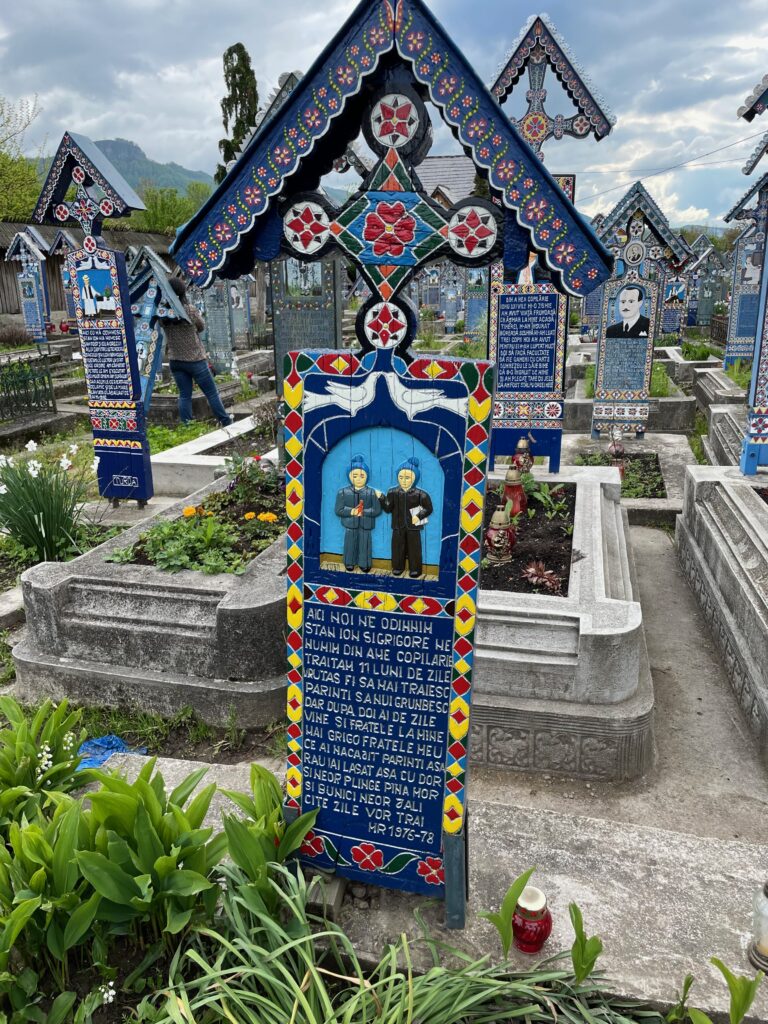
ACI NOI NE ODIHNIM
STAN ION ȘIGRIGORE NE
NUMIM DIN AME COPILĂRIE
TRĂITAM 11 LUNI DE ZILE
VRUTAȘ FI SĂ MAI TRĂIESC
PĂRINȚI SĂNUI GRUNBESC
DAR DUPĂ DOI AI DE ZILE
VINE ȘI FRATELE LA MINE
MAI GRIGO FRATELE MEU
CE AI NĂCĂJIT PĂRINȚI AȘA
RĂU IAI LĂSAT AȘA CU DOR
SI NEOR PLÎNGE PÎNĂ MOR
ȘI BUNICI NEOR JĂLI
CÎTE ZILE VOR TRĂI
MR 1976-78
Here we rest quite cold,
Stan Ion and Grigore we’re called.
My childhood was indeed brief,
11 moths full of grief.
I wish I had lived longer
So my parents wouldn’t suffer.
But two years later
My brother followed me:
Oh, Grigo, my dearest brother
Why did you upset our parents so much?
As long as they’ll live
Our parents and grandparents
In sorrow and mourning will be!
Died 1976-1978.
EU AICI MĂ ODIHNESC
MIHAICA ION MĂ NUMESC
CÎT AM TRĂIT PE PĂMÎNT AM
FOST MUNCITOR LA RÎND AM
MUNCIT MULT LA PĂDURE CU ȚAPIN ȘI CU SĂCURE ȘIDACĂ
AM ÎMBĂTRÎNIT NU MAM HRĂ
NIT DE MUNICT AM AVUT
TREI COPILAȘI ȘI MI-A FOST
PE LUME DRAGI PE TOADER
ȘI PE MUERE II LAS EU CU
MARE JELE CĂCI VIAȚA O
LĂSAT LA 81 ANI
A MURIT ÎN 1982

Epitaph of Ion Mihalca. Photo: D.M. (May 2021)
I rest here quite cold,
Mihaica Ion I was called.
I worked my whole life
In the forrest, with cant hook and axe, and even when I
was getting older, I did not
shy away from work. I had
three little children
which were very dear to me.
Toader and my wife,
I leave them in great grief,
for I ended my life’s span
when I was eighty-one.
Died in 1982.
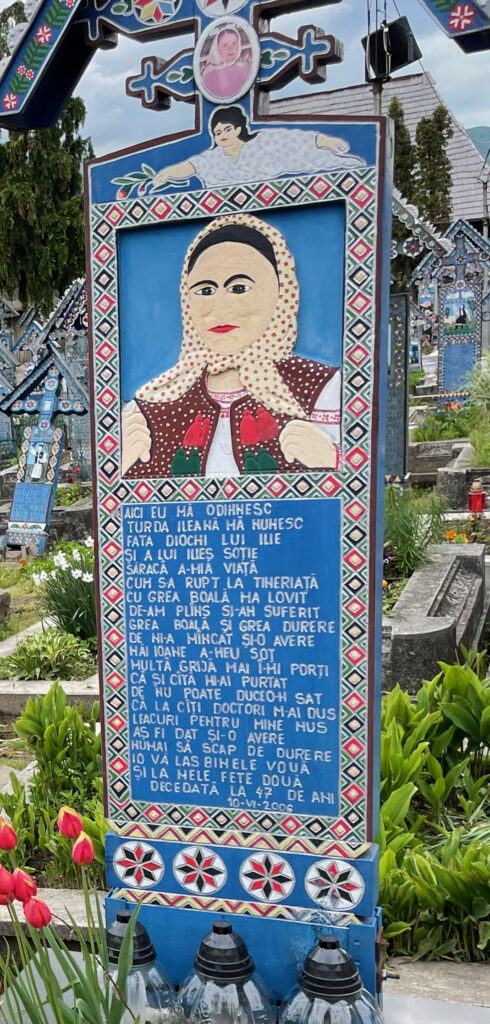
AICI EU MĂ ODIHNESC
TURDA ILEANĂ MĂ NUMESC
FATA DIOCHI LUI ILIE
ȘI A LUI ILIEȘ SOȚIE
SĂRACĂ A-MIA VIAȚĂ
CUM S-A RUPT LA TINEREAȚĂ
CU GREA BOALĂ MA LOVIT
DE-AM PLÎNS ȘI-AM SUFERIT
GREA BOALĂ ȘI GREA DURERE
DE NI-A MÎNCAT ȘI-O AVERE
MĂI IOANE A-MEU SOȚ
MULTĂ GRIJĂ MAI Î-MI PORȚI
CĂ ȘI CÎTĂ MI-AI PURTAT
DE NU POATE DUCEO-N SAT
CĂ LA CÎȚI DOCTORI M-AI DUS
LEACURI PENTRU MINE NUS
AȘ FI DAT ȘI-O AVERE
NUMAI SĂ SCAP DE DURERE
IO VĂ LAS BINELE VOUĂ
ȘI LA MELE FETE DOUĂ
DECEDATĂ LA 47 DE ANI
10-VI-2006
Funerary inscription of Ileana Turda. Photo: D.M. (May 2021).
I rest here quite cold
And Turda Ileana I was called,
Daughter of Ilie aka Diochi
And wife of Ilieș.
Oh, my life was very brief
And it ended in great grief.
A great disease,
In tears and misery, I fought.
Great disease and great suffering
That has consumed our entire fortune!
You, Ioane, my dear husband,
You took care of me
More than ever found in this village!
You’ve taken me to many doctors,
But for me there’s no cure:
I would have given my whole fortune
Only to get rid of the pain,
But that was also not possible,
So I wish you and my two daughters all health!
Died at 47, on the 10th of June 2006.
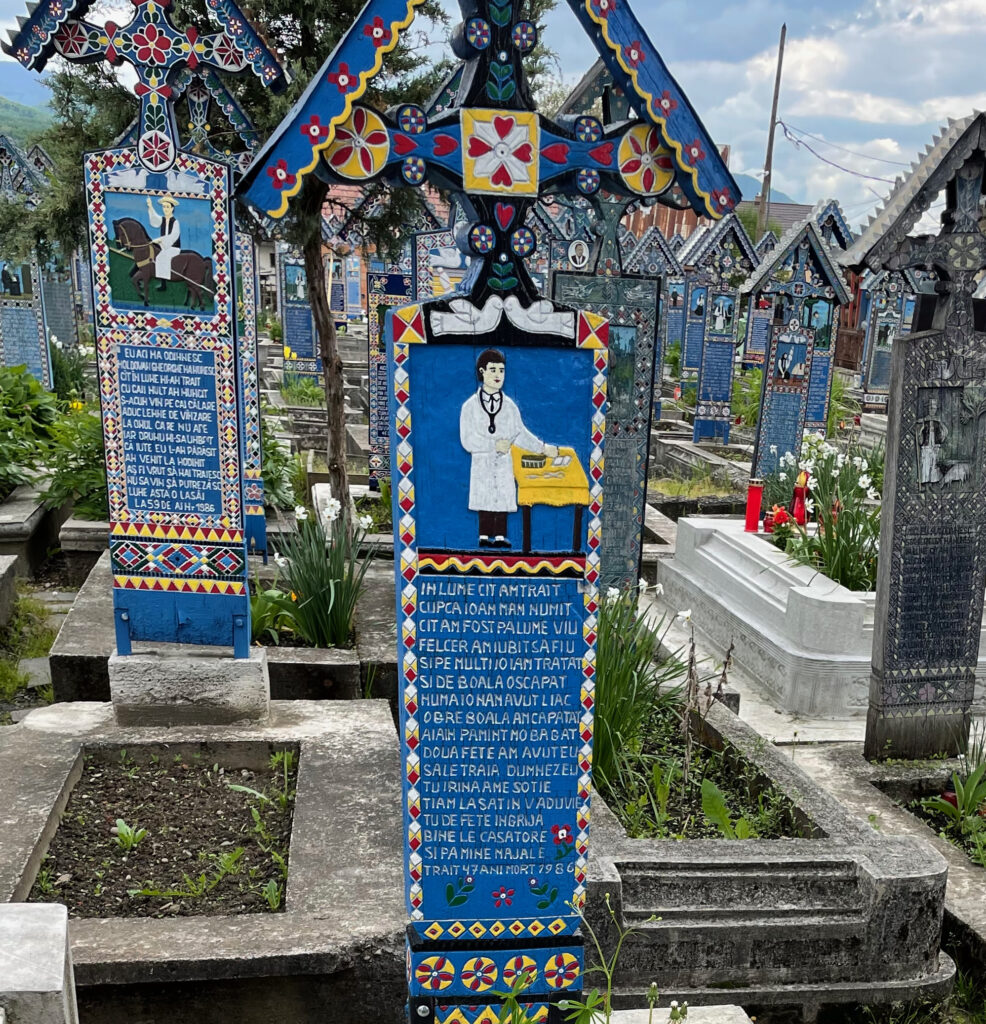
ÎN LUME CÂT AM TRĂIT
CUPCA IOAN MAM NUMIT
CÎT AM FOST PĂLUME VIU
FELCER AM IUBIT SĂ FIU
ȘI PE MULȚI IO IAM TRATAT
SI DE BOALĂ OSCĂPAT
NUMAI IO NAM AVUT LIAC
O GRE BOALĂ AMCĂPĂTAT
AIAÎN PĂMÎNT MO BĂGAT
DOUĂ FETE AM AVUTEU
SĂLE TRĂIA DUMNEZEU
TU IRINAAME SOȚIE
ȚIAM LĂSAT ÎN VĂDUVIE
TU DE FETE ÎNGRIJA
BINE LE CĂSĂTOREA
ȘI PĂMINE MAJALE
TRĂIT 47 ANI MORT 1986
Funerary inscription of Ioan Cupca. Photo: D.M. (May 2021)
Cupca Ioan I was called,
And for as long I lived I could not image
Being anything other than a doctor:*
I treated many patients,
And I got rid of their disease
But I myself, I could not escape,
For a serious illness
Put me quickly into the grave.
I had two daughters.
May God give them a long life.
And you, my dear wife, Irina,
I have left you a widow:
You be careful whom
you marry the girls to,
and remember to mourn me.
Lived 47 years. Died in 1986.
(*worked mainly in the village)
Finally, on a slightly, ahem, shall we say: merrier note:
ȚUICA E CURAT VENIN
E ADUCE PLÎNS ȘI CHIN
CĂ ȘI MIE MI-O ADUS
MOARTEA SUB PICIOR M-O PUS
CUI ÎI PLACE ȚUICA BINE
VA PĂȚII LA FEL CA MINE
CĂ EU ȚUICA AM IUBIT
CU EA-N MÂNĂ AM MURIT
AICI ODIHNEȘTE
DUMITRU HOLDIȘ
A TRĂIT 45 DE ANI
MORT DE MOARTE
FORȚATĂ LA 1958
Plum brandy is real poison,
It takes you onto a path of sorrow:
It brought the same for me,
And Death placed me under its feet.
To those who love plum brandy:
You will have the same destiny as me,
For I died as I held tight to my bottle.
Here lies
Dumitru Holdiș
Who died at the age of forty five years,
Driven to death by bottle, in 1958.
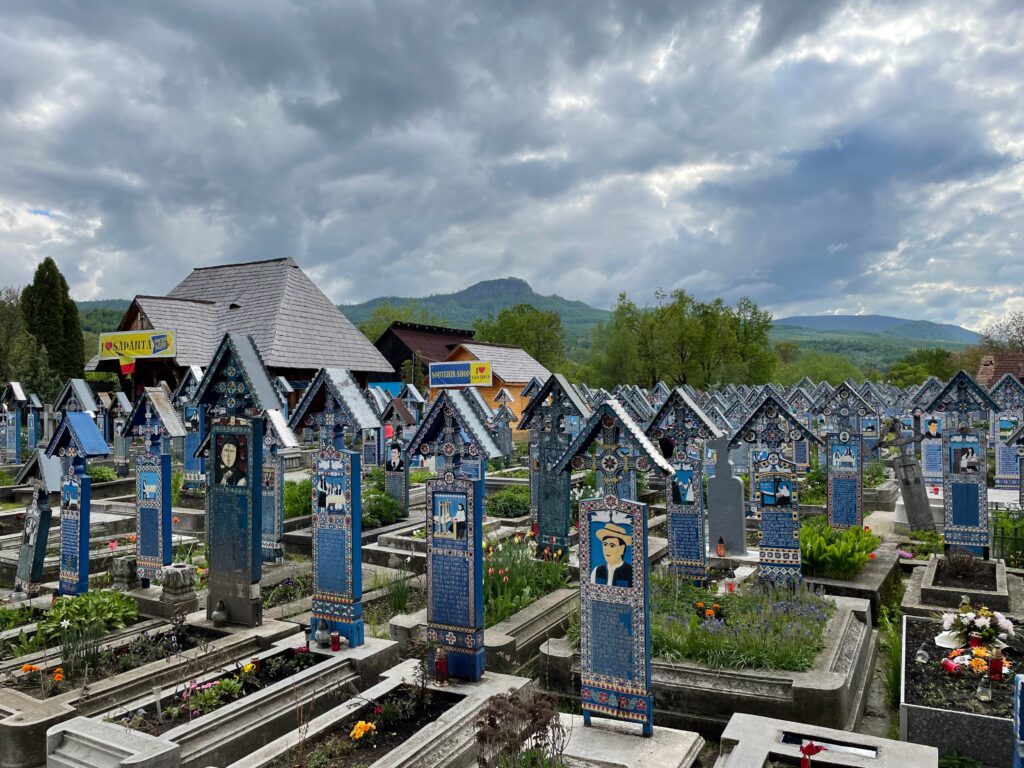
None of the stories that we chose to present here were especially cheerful. Ultimately, they all were testimony to hardship, suffering, loss, and pain.
But they all are stories written by life itself.
And as we conclude this month’s post, you might want to ask yourself: how do you now leave this place, this colourful, bold poetic landscape that lets vitality vividly outshine the pain and sorrow of our human existences?
Sad?
Shocked?
Or, following this encounter with very real humans, with a deep sense of catharsis and relief, and, in fact, feeling a bit merry?

